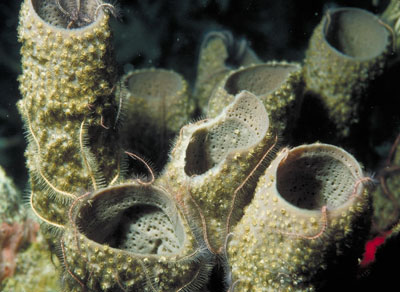Sponges are the most primitive of the multicellular animals, they have been around on earth for 600 million years or more. They are overwhelmingly marine organisms, out of about 15,000 species only around 150 are found in freshwater. They feed on suspended organic matter in the water that is frequently too small for other filter feeders to access.
Porifera - Sponges
Typical Poriferans
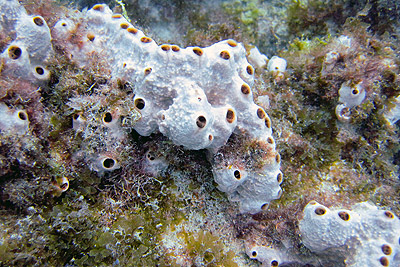
A typical small encrusting sponge
picture - Joi Ito under CC2
Attribution Generic licence
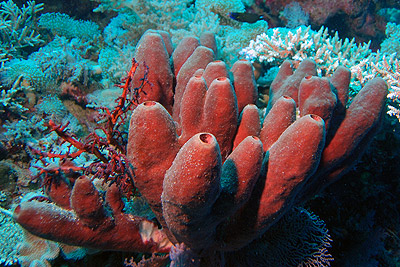
Sponges come in a range of colours,
often very bright in life.
Cool Poriferans
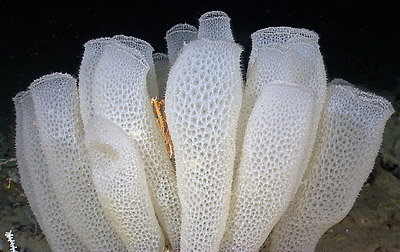
A glass sponge, Euplectella_aspergillum,
popularly known as "Venus's flower basket."
picture courtesy NOAA

Branching Vase Sponge, Callyspongia
vaginalis
picture - Nhobgood, Nick Hobgood,
used under CC3 Attribution Share Alike Unported licence.
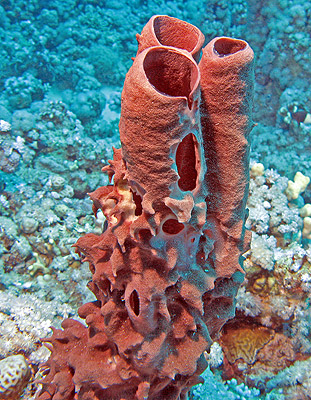
Red Tube Sponge
picture Neno69, used under
CC3 Attribution Share Alike Unported licence
Kingdom - Animalia
Phylum - Porifera
Basic Features:
- Sessile aquatic organisms, fixed in one place.
- Multicellular organisms with few cell types.
- Filter feeders on bacteria and other organic material in the water column.
- No circulatory, digestive or nervous system, no true tissues or organs, gas exchange and excretion are by diffusion across the cell walls.
- Some cells can migrate within the sponge and are able to become other types of cells.
- The body shape is designed to optimize water flow which generally enters laterally (at the sides) through pores (ostia) and leaves through a top chimney-like hole called the osculum.
- Body plan consists of a mesohyl layer of non-living skeletal tissue sandwiched between two layers of cells.
- Reproduction can be asexual or sexual, sponges are hermaphrodite (male and female at the same time).
- Found world-wide in mainly marine environments although there are a smaller number of freshwater species.
What are sponges like?
They vary greatly in size, some are only as big as a grain of rice, others could hold a fully grown person.
They are frequently brightly coloured and were thought to be plants until 1765 when internal water currents were seen for the first time.
 Sponges
have cells called choanocytes (pictured right) that
have whip-like flagella that they wave to set up water
currents that bring in food and oxygen and remove waste.
Such currents are even used to move sperm and eggs out
of the sponge. The flow of water is inwards through
pores in the outer walls of the sponge and then out
through the chimney-like osculum. Differences in water
flow at the top of this osculum and the bottom of the
sponge also helps with the flow of water.
Sponges
have cells called choanocytes (pictured right) that
have whip-like flagella that they wave to set up water
currents that bring in food and oxygen and remove waste.
Such currents are even used to move sperm and eggs out
of the sponge. The flow of water is inwards through
pores in the outer walls of the sponge and then out
through the chimney-like osculum. Differences in water
flow at the top of this osculum and the bottom of the
sponge also helps with the flow of water.
A non-living mesohyl layer of sponges contains a matrix of dispersed collagen fibrils. They may also contain spicules made of coarse flexible collagen fibres called spongin or they made be made of stiff silica (as in the glass-sponges) or calcium carbonate. They may be simple and rod-like or they may branch and have a three-dimensional structures (see picture of spicules further down this page). These spicules may be very characteristic of the sponge and are often important in identifying the species.
The more complex spicules may interlock for additional support and sometimes extend beyond the outer layer of cells, the pinaocytes.
What do Poriferans eat?
Sponges feed on very fine particles suspended in the water. In some tropical sponges, 80% of the material filtered from the water is smaller than a size that can be resolved with a light microscope. The remaining 20% were made of bacteria, dinoflagellates and other very small plankton.
1cm3 of sponge tissue can filter 20 liters of water a day, 20,000 times its own volume.
In tropical waters in particular there is much more of this very fine organic matter in the water than there is plankton, sponges do well here by being able to use this food source. Digestion of food is inside cells (intracellular) within a food vacuaole, possible as the particles are so small.
What eats Poriferans?
There are not many things that eat sponges, partly because they are not very nutritious, partly because they are tough with all that collagen and those spicules and partly as they often have chemical toxins as defence.
Some sea slugs (nudibranchs) will eat them as will some starfish and there is a group of flies called the sponge-flies whose larvae feed on freshwater sponges.
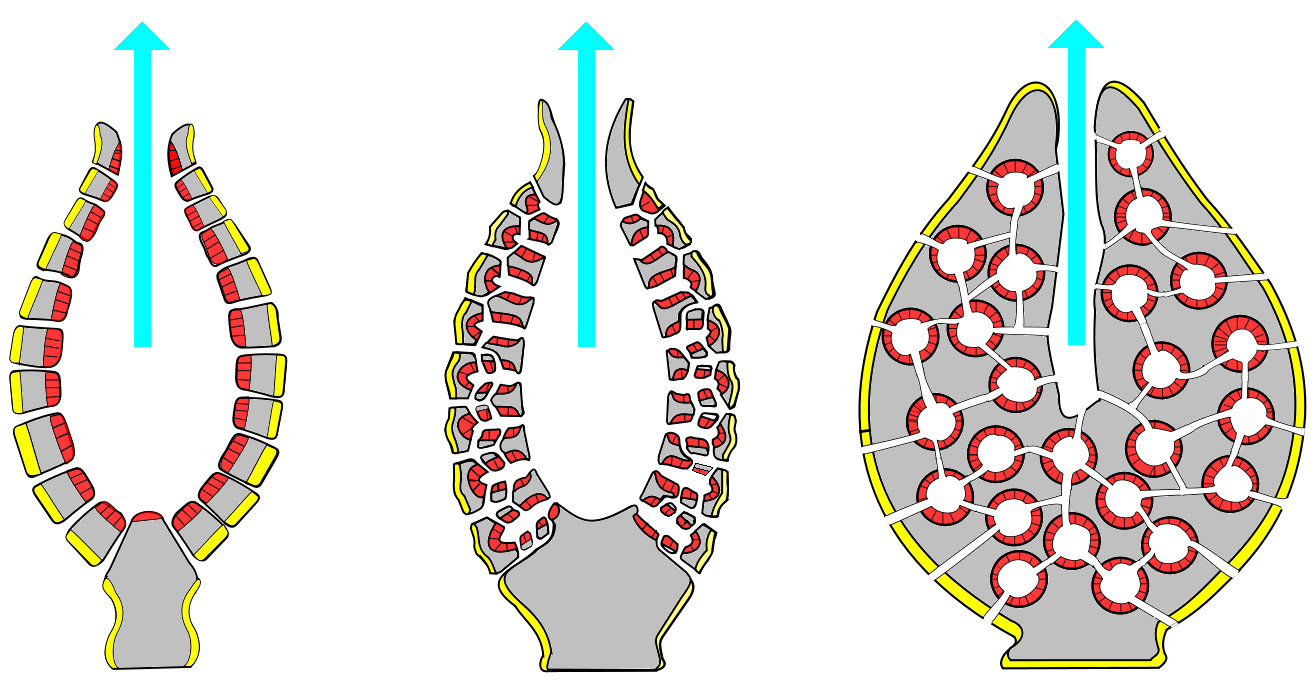
The structure of different sponge types
picture used permission of Philcha,
published under Creative Commons Attribution ShareAlike 3.0
License
Yellow - pinacocytes, cells that cover the
outside of the sponge, one cell thick. Those at the base secrete
a glue that fixes the sponge to the rock or other attachment.
Red - choanocytes, cells with a cilium,
a whip-like structure that wave and cause the flow of water
through the sponge
Grey - mesohyl, none-living
jelly-like medium that is embedded with spongin fibres and spicules
made of silica or calcium carbonate
Blue
- water flow

Microscopic spicules from a sponge
Spicules join together to form the skeleton of sponges, the
things sold as "natural sponges" or "loofahs" once they have
dried out. The different shapes come from different species,
though one species may have several types.
picture - Rob W. M. Van Soest, Nicole
Boury-Esnault, Jean Vacelet, Martin Dohrmann, Dirk Erpenbeck,
Nicole J. De Voogd, Nadiezhda Santodomingo, Bart Vanhoorne,
Michelle Kelly, John N. A. Hooper, used under CC2.5 Attribution
Generic licence
Sea Sponges in the Abyss
Feeding in Sponges, a fluorescent
dye is introduced around the sponge which then
moves through
the walls before being ejected through the top opening.

